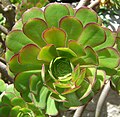| Tree aeonium | |
|---|---|

| |
| Scientific classification | |
| Kingdom: | Plantae |
| Clade: | Tracheophytes |
| Clade: | Angiosperms |
| Clade: | Eudicots |
| Order: | Saxifragales |
| Family: | Crassulaceae |
| Genus: | Aeonium |
| Species: | A. arboreum
|
| Binomial name | |
| Aeonium arboreum | |
| Synonyms[1] | |
| |
Aeonium arboreum, the tree aeonium,[2] tree houseleek, or Irish rose,[citation needed] is a succulent, subtropical subshrub in the flowering plant family Crassulaceae.
It is an invasive weed in places outside its natural distribution, for example as a garden escape throughout temperate southern Australia.[citation needed]
Description[edit]

Aeonium arboreum grows as a less branched subshrub and reaches stature heights of up to 2 metres. The more or less upright or ascending, smooth, not net-like patterned stem axes have a diameter of 1 to 3 centimetres.
Their leaves are in flattened rosettes with diameters of 10 to 25 centimetres at the end of the stem axes together. Young leaves are pressed tightly together. The obovate to oblate lanceolate leaf blade is pointed toward its apex and wedge-shaped at the base. It is 130 to 380 mm (5 to 15 in) long, 25 to 115 mm (1 to 4+1⁄2 in) wide and 1.5 to 3 millimetres thick. The green, usually purple-colored, glossy leaf surface is almost bare. The leaf margin is set with curved eyelashes.
The conical to ovate inflorescence has a length of 10 to 25 centimetres and a diameter of 10 to 15 centimetres. The inflorescence stem is 130 to 510 mm (5 to 20 in) long. The flowers sit on a 2-to-12-millimetre-long, slightly fluffy flower stem. Its sepals are also slightly fluff-haired with a pointed top and wedge-shaped base that is smooth and shiny green, red or purple. The yellow, narrow oblong to lanceolate, pointed petals are 5 to 7 millimetres long and 1.5 to 2 millimetres wide. The stamens are bare. It bears rosettes of leaves and large pyramidal panicles of bright yellow flowers in the spring.[3]
Distribution[edit]
The plant is endemic to the western Canary Islands of Tenerife, La Palma, El Hierro, La Gomera and Gran Canaria. The populations found on the Iberian Peninsula, the Moroccan coast and the Mediterranean are likely to be considered neophytes.[4] In temperate regions it needs to be grown under glass.
Cultivation[edit]
Aeonium arboreum grows in sunny or slightly shaded places on weathered volcanic soil.[5] The purple cultivar 'Zwartkop' ('Schwartzkopf') has gained the Royal Horticultural Society's Award of Garden Merit.[6] A variegated form is grown as cultivar 'variegatum'.
Varieties[edit]
The following variety names are accepted.[1]
- Aeonium arboreum var. arboreum
- Aeonium arboreum var. holochrysum H.Y.Liu
- Aeonium arboreum var. rubrolineatum (Svent.) H.Y.Liu
Gallery[edit]
-
Inflorescence
-
Aeonium arboreum 'Atropurpureum'
-
Aeonium arboreum 'Zwartkop'
-
Botanical illustration
-
Flower close up
-
Potted
-
Variegated
-
Rosette of leaves
-
Aeonium arboreum 'Medusa'
References[edit]
- ^ a b The Plant List: A Working List of All Plant Species, retrieved 30 July 2016
- ^ BSBI List 2007 (xls). Botanical Society of Britain and Ireland. Archived from the original (xls) on 2015-06-26. Retrieved 2014-10-17.
- ^ Reto Nyffeler: Aeonium . In: Urs Eggli (ed.): Succulent Encyclopedia Volume 4 Crassulaceae (thick-leafed plants) . Eugen Ulmer Verlag, Stuttgart 2003, ISBN 3-8001-3998-7 , p 13.
- ^ "International Crassulaceae Network: Aeonium arboreum". International Crassulaceae Network. Retrieved 19 February 2017.
- ^ RHS A-Z encyclopedia of garden plants. United Kingdom: Dorling Kindersley. 2008. p. 1136. ISBN 978-1405332965.
- ^ Aeonium 'Zwartkop' AGM. Archived 2014-03-28 at the Wayback Machine Royal Horticultural Society
External links[edit]
- "Aeonium arboreum". Integrated Taxonomic Information System. Retrieved September 25, 2006.
- House tree-leek. Retrieved February 7, 2011.








